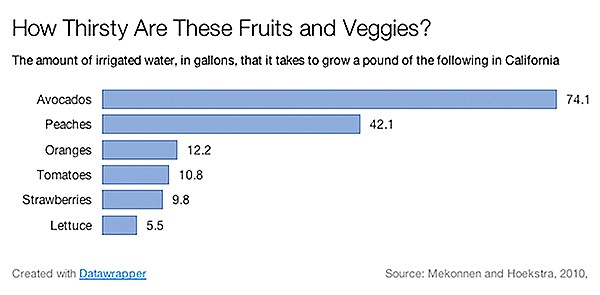 Facebook
Facebook
 X
X
 Instagram
Instagram
 TikTok
TikTok
 Youtube
Youtube

Have you noticed? Economic principles are being turned upside down right before our eyes. It’s happening in grocery stores. Avocados are getting much bigger, but prices are getting cheaper. It’s like paying more for a new VW Jetta than for a new Cadillac Escalade.
Mexico is growing those big avocados. On the other hand, California-grown avocados are just coming on the market now, and they are smaller than normal. This has a magnifying effect on the big ones.
Why the size differential? “The Mexicans had a better-than-average crop with very good growing conditions,” says Fallbrook’s Jim McCormac, who writes a newsletter, The Weekly Newsline, for professional growers. “They had more big fruit. It was a good growing year.”

By contrast, California growers were disappointed that El Niño didn’t produce as much water as expected. “Some heat spells during the late winter” caused fruit to drop earlier than normal. The stress of the drought was a factor. “So, growers were picking earlier than normal.” And the result was smaller avocados.
The grocery store juxtaposition of large and small avocados — called a “sizing mismatch” in the industry — is one factor in today’s low prices.

Also, there is a supply-demand imbalance — not an unusual phenomenon. Importers possibly expected more consumption at the time of the Super Bowl. The Mexican growers dominate the market in the winter, and importers anticipated larger demand than they got. “They were hoping demand would go through the roof. It was strong, but not as strong as expected,” says Tom Bellamore, president of the California Avocado Commission in Irvine. Importers “licked their lips,” thinking of all the guacamole that would be devoured during the Super Bowl. The less-capitalized importers got the greediest. “A lot of small guys were sending in loads and the price started to weaken.” The smaller, “less sophisticated” importers apparently over-ordered avocados.
“There is no reason why wholesale prices should weaken if people are disciplined in what they send to market,” says Bellamore. “There is a lot of information out there on what demand is likely to be. Importers are buying too much.” He thinks that these overbuyers may be smaller companies that operate at the border.
All things considered, “It’s an aberration that prices are as low as they are now,” says Bellamore. “It’s mind-boggling to us.”
McCormac’s mind, however, is not so boggled for an explanation. “Wholesale buyers are creatures of habit,” he says. They get accustomed to a particular-sized carton of avocados. Their computers expect that size. When some fruit is extra-large and some smaller than normal, the carton sizes may vary. Some smaller, upscale retailers prefer the large avocados, while the mass retailers such as Vons want the average-sized avocados. Many retailers don’t get what they want at the time they want it.
Chauvinist San Diegans tend to think of their county as the world’s biggest avocado producer. Ain’t so — by a long shot. Mexico took the lead years ago and continues to gain. Countries such as Chile and Peru have smaller pieces of the U.S. market. Avocados are grown in many subtropical areas with little frost and wind, such as parts of Spain, Portugal, Morocco, Colombia, South Africa, Vietnam, and Indonesia.

California produces 90 percent of the United States avocado crop, and San Diego produces 60 percent of that. Fallbrook, where McCormac lives, considers itself the “Avocado Capital of the World.”
Last month, Mexico shipped about nine times as many avocados as California, according to San Juan Capistrano’s California Avocado Society, which sends out McCormac’s newsletter. By the end of this year, after California production has picked up, “Mexico will ship close to two billion pounds while California shipments are expected to be 380 million to 400 million,” says Bellamore. The gap will narrow but still be wide.
There are mixed views on this sizing mismatch. Optimists think that with prices at historically low levels, retailers will push avocados more heavily in their advertising and promotions. This will enlarge the market. And there is room to grow. In the United States, consumption is growing at more than 10 percent a year. Per capita consumption has grown from “a pound or two per capita to five or six pounds per capita,” says McCormac.
Bellamore is more bullish. He says that in the U.S., “the average [consumption] is around eight pounds per person.”
Early on, avocados were considered a Western repast. But in recent years they have penetrated the eastern United States while expanding in the West.
In their early days, avocados in the United States were considered a seasonal fruit, not available in winter months. That changed when Mexico entered the U.S. market and monopolized distribution in winter months. Initially, there was resistance to the Mexican suppliers. California growers, McCormac says, “spent tens of millions of dollars over years to develop the market, and now foreign countries are coming in with no assessment — freeloading.” Custom payments were set up.
After the North American Free Trade Agreement (NAFTA) went into effect in 1994, Mexico tried exporting avocados to the United States, which resisted on the ground that fruit flies would destroy California crops. The issue was settled when Mexico agreed to sell avocados only in the northeast. Later, Peru and Chile joined Mexico as exporters to the United States.
Today, the deal is considered a boon to the business. The area of the United States that wasn’t exposed to avocados — the East — is now a good market.

But all is not well in the California avocado industry. The villain: lack of water. It takes 74.1 gallons of water to grow a pound of avocados. Oranges take 12.2 gallons, tomatoes 10.8, and lettuce 5.5. “For a guy who grows nursery plants, water is maybe 15 percent of operating costs,” says McCormac. “For the avocado grower, it is 60 percent.”
That’s a major reason why the number of California growers has dropped to 4000 from 5000 five years ago, says Bellamore.
McCormac says professional growers haven’t dropped out of the business at the same rate as the amateurs because the pros have more experience battling the elements. The ones dropping out are retired business executives who bought a plot in North County and decided to grow avocados. Those are the ones fleeing the business rapidly.


Have you noticed? Economic principles are being turned upside down right before our eyes. It’s happening in grocery stores. Avocados are getting much bigger, but prices are getting cheaper. It’s like paying more for a new VW Jetta than for a new Cadillac Escalade.
Mexico is growing those big avocados. On the other hand, California-grown avocados are just coming on the market now, and they are smaller than normal. This has a magnifying effect on the big ones.
Why the size differential? “The Mexicans had a better-than-average crop with very good growing conditions,” says Fallbrook’s Jim McCormac, who writes a newsletter, The Weekly Newsline, for professional growers. “They had more big fruit. It was a good growing year.”

By contrast, California growers were disappointed that El Niño didn’t produce as much water as expected. “Some heat spells during the late winter” caused fruit to drop earlier than normal. The stress of the drought was a factor. “So, growers were picking earlier than normal.” And the result was smaller avocados.
The grocery store juxtaposition of large and small avocados — called a “sizing mismatch” in the industry — is one factor in today’s low prices.

Also, there is a supply-demand imbalance — not an unusual phenomenon. Importers possibly expected more consumption at the time of the Super Bowl. The Mexican growers dominate the market in the winter, and importers anticipated larger demand than they got. “They were hoping demand would go through the roof. It was strong, but not as strong as expected,” says Tom Bellamore, president of the California Avocado Commission in Irvine. Importers “licked their lips,” thinking of all the guacamole that would be devoured during the Super Bowl. The less-capitalized importers got the greediest. “A lot of small guys were sending in loads and the price started to weaken.” The smaller, “less sophisticated” importers apparently over-ordered avocados.
“There is no reason why wholesale prices should weaken if people are disciplined in what they send to market,” says Bellamore. “There is a lot of information out there on what demand is likely to be. Importers are buying too much.” He thinks that these overbuyers may be smaller companies that operate at the border.
All things considered, “It’s an aberration that prices are as low as they are now,” says Bellamore. “It’s mind-boggling to us.”
McCormac’s mind, however, is not so boggled for an explanation. “Wholesale buyers are creatures of habit,” he says. They get accustomed to a particular-sized carton of avocados. Their computers expect that size. When some fruit is extra-large and some smaller than normal, the carton sizes may vary. Some smaller, upscale retailers prefer the large avocados, while the mass retailers such as Vons want the average-sized avocados. Many retailers don’t get what they want at the time they want it.
Chauvinist San Diegans tend to think of their county as the world’s biggest avocado producer. Ain’t so — by a long shot. Mexico took the lead years ago and continues to gain. Countries such as Chile and Peru have smaller pieces of the U.S. market. Avocados are grown in many subtropical areas with little frost and wind, such as parts of Spain, Portugal, Morocco, Colombia, South Africa, Vietnam, and Indonesia.

California produces 90 percent of the United States avocado crop, and San Diego produces 60 percent of that. Fallbrook, where McCormac lives, considers itself the “Avocado Capital of the World.”
Last month, Mexico shipped about nine times as many avocados as California, according to San Juan Capistrano’s California Avocado Society, which sends out McCormac’s newsletter. By the end of this year, after California production has picked up, “Mexico will ship close to two billion pounds while California shipments are expected to be 380 million to 400 million,” says Bellamore. The gap will narrow but still be wide.
There are mixed views on this sizing mismatch. Optimists think that with prices at historically low levels, retailers will push avocados more heavily in their advertising and promotions. This will enlarge the market. And there is room to grow. In the United States, consumption is growing at more than 10 percent a year. Per capita consumption has grown from “a pound or two per capita to five or six pounds per capita,” says McCormac.
Bellamore is more bullish. He says that in the U.S., “the average [consumption] is around eight pounds per person.”
Early on, avocados were considered a Western repast. But in recent years they have penetrated the eastern United States while expanding in the West.
In their early days, avocados in the United States were considered a seasonal fruit, not available in winter months. That changed when Mexico entered the U.S. market and monopolized distribution in winter months. Initially, there was resistance to the Mexican suppliers. California growers, McCormac says, “spent tens of millions of dollars over years to develop the market, and now foreign countries are coming in with no assessment — freeloading.” Custom payments were set up.
After the North American Free Trade Agreement (NAFTA) went into effect in 1994, Mexico tried exporting avocados to the United States, which resisted on the ground that fruit flies would destroy California crops. The issue was settled when Mexico agreed to sell avocados only in the northeast. Later, Peru and Chile joined Mexico as exporters to the United States.
Today, the deal is considered a boon to the business. The area of the United States that wasn’t exposed to avocados — the East — is now a good market.

But all is not well in the California avocado industry. The villain: lack of water. It takes 74.1 gallons of water to grow a pound of avocados. Oranges take 12.2 gallons, tomatoes 10.8, and lettuce 5.5. “For a guy who grows nursery plants, water is maybe 15 percent of operating costs,” says McCormac. “For the avocado grower, it is 60 percent.”
That’s a major reason why the number of California growers has dropped to 4000 from 5000 five years ago, says Bellamore.
McCormac says professional growers haven’t dropped out of the business at the same rate as the amateurs because the pros have more experience battling the elements. The ones dropping out are retired business executives who bought a plot in North County and decided to grow avocados. Those are the ones fleeing the business rapidly.
Comments